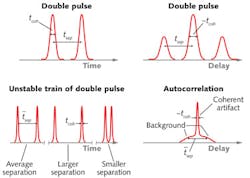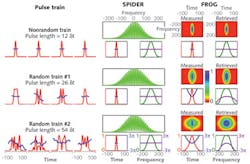MICHELLE RHODES, SAIDUR RAHAMAN, PAMELA BOWLAN, GÜNTER STEINMEYER, and RICK TREBINO
In the 1960s, laser pulses broke the nanosecond barrier, becoming shorter than could be measured with electronics, and the field of ultrashort-laser-pulse measurement was born. A technique called autocorrelation emerged, involving splitting the pulse into two replicas, variably delaying one, overlapping them in a nonlinear-optical medium, and measuring the generated nonlinear-optical pulse energy vs. delay. Unfortunately, autocorrelation yielded only a blurry black-and-white picture of the pulse.
Worse, autocorrelation traces also exhibited a highly inconvenient feature known as the coherent artifact—a short central spike that indicated only the shortest temporal structure in the pulse intensity (see Fig. 1).1 In reality, the broader background underneath the spike indicated the true pulse length. The more unstable the pulse train, the larger the discrepancy between the widths of these two components of the trace.Regrettably, because shorter pulses are usually very desirable, wishful thinking led many to confuse the coherent artifact for the actual much longer and more complex pulse in an unstable pulse train. Fortunately, over time, careful evaluation of autocorrelation traces, along with some creative guesswork, allowed researchers to shorten pulse lengths to femtosecond durations. The coherent artifact's misinterpretations fell into the folklore of the field, in the hope that this mistake would never be repeated.
In 1991, with achievable pulse lengths well into the femtosecond regime, a technique called frequency-resolved optical gating (FROG) emerged that simply involved spectrally resolving the nonlinear-optical signal pulse in an autocorrelator. FROG proved capable of measuring the complete temporal intensity and phase of an arbitrary femtosecond pulse, yielding, in effect, a full-color high-definition picture of it. And because FROG traces (spectrograms) are functions of delay and frequency, much more information resides in a FROG trace than in an autocorrelation. Indeed, FROG, with its robust phase-retrieval algorithm, proved immune to most of autocorrelation's afflictions. Several years later, another femtosecond-pulse-intensity-and-phase measurement technique emerged, called spectral interferometry for direct electric-field reconstruction (SPIDER), which retrieves the pulse spectral phase by interfering two pulse replicas up-converted to slightly different center frequencies.
Fooled again by the coherent artifact
Perhaps because these new techniques succeeded in many of the ways in which autocorrelation failed, the coherent artifact was all but forgotten. With a little thought, however, it is clear that a measurement technique can output only one pulse and so must necessarily fail to represent an unstable train comprising different pulses. The best possible result is a "typical" pulse, along with feedback indicating instability.
Although femtosecond lasers can be quite stable when properly aligned, many are unstable, and misalignment is a fact of life in the laser lab. More importantly, it is vital to be able to recognize instability when unexpected. In a world where simple, short, and stable pulses are greatly valued, their measurement must be more than mere wishful thinking (a coherent artifact). The burden of proof is on the measurer. In the words of Wayne Knox, past director of the University of Rochester's Institute of Optics, "If you haven't measured it, you haven't made it."2
Recently, the long-overdue study of the coherent artifact in FROG and SPIDER technique occurred, and the results were shocking for many. Simulations (see Fig. 2) involved one stable train of short pulses and two unstable trains of longer pulses, the latter comprising the stable train's short pulse plus longer random components.3,4 It was found that neither method retrieves a typical pulse in the unstable trains, but FROG's pulse lengths are at least reasonable.Also, discrepancies between the measured and retrieved FROG traces give clear feedback that the retrieved pulse is not reliable due to the instability. SPIDER, on the other hand, measures only the coherent artifact and so significantly underestimates the pulse length and complexity. A small amount of background is its only indication of instability. However, benign SPIDER-device misalignments also yield identical background. In short, SPIDER cannot distinguish a stable train of short pulses from an unstable train of longer pulses. The same is true for other interferometric techniques.
The unambiguous conclusion is that much greater care must be taken in pulse measurements. The ultimate solution is to perform, if possible, single-shot measurements, which, happily, are readily available. Instead of reflecting a pulse off a movable mirror, which generates only one delay at a time, the measurements involve crossing the two pulse replicas at a large angle, so that delay varies with transverse position. Imaging the nonlinear medium onto a camera simultaneously yields all delays and hence a single-shot measurement.
As a result of such care and single-shot measurements, femtosecond laser pulses are actually arguably the best-characterized type of light, even better than continuous-wave (CW) light, which still requires a statistical description. Femtosecond pulse-measurement methods have helped ultrashort pulses to achieve a wide range of applications and to enter even shorter temporal regimes. And femtosecond lasers are now the most stable light sources ever developed.
Measuring the pulses that started it all
But what about the ~1 ns pulses that gave birth to the field of pulse measurement to begin with? In pressing to ever-shorter pulse lengths, the measurement of these longer, less exotic pulses was nearly forgotten. Pulses from Q-switched solid-state lasers, diode lasers, and fiber lasers have remained essentially immeasurable.5 Not coincidentally, these longer pulses are typically very complex in time and may be the least-stable laser pulses available. These lasers also suffer from the poorest specifications, making purchasing decisions very difficult. Very expensive oscilloscopes and streak cameras yield only blurry black-and-white images of them. So the question naturally arises: can the femtosecond world's more informative, full-color, high-definition, and much less expensive measurement techniques extend to these much longer pulses?
This is a very important question because ~1 ns pulses, despite their instability, are much more common and have a wide array of critical applications, including materials processing, welding, machining, surgery, ranging, remote sensing, military devices, and basic science. Better pulse monitoring would quickly alert users to laser misalignment or imminent failure and so would increase manufacturing yields, save money, accelerate scientific progress, and reduce medical complications. And improved measurement would inevitably lead to improvements in these lasers and propel us even further into a highly desirable future.
In view of these lasers' severe instability and the ever-present coherent artifact, a single-shot method is essential. But, counterintuitively, measuring a nanosecond pulse is actually much harder than measuring a femtosecond one. The challenge is the required delay range. The traditional moving-mirror approach is impractical: a delay of three nanoseconds requires light propagation of a meter, yielding a device as large, complex, and expensive as the laser itself. And, of course, this still does not solve the problem of generating all of these delays on a single shot.
A trick first developed in the 1980s is to overlap in the nonlinear-optical medium pulses that are oppositely tilted. A ~45° tilt can be achieved by diffracting a pulse off a grazing-incidence grating (simple ray-tracing shows that tilt must result), achieving up to tens of picoseconds of delay. Recently, this idea was implemented in a FROG.6 Unfortunately, nanosecond pulses require much larger delays.
Noting that 90° tilt is physically impossible, consider that measuring a ~1 ns pulse requires a tilt that is a mere 0.01° away from 90° (89.99°). Worse, the pulse must not be distorted in any other way. As a result, a reasonable person might abandon this challenge, but in fact it is possible to accomplish this feat.7 Entering an etalon at one edge (see image at the top of this page), a pulse propagates back and forth and slowly across it, yielding a massively tilted transmitted pulse.8 In addition, simultaneously allowing one pulse to enter an etalon at its left edge and another at its right edge yields two spatially overlapped, crossed, and oppositely tilted pulses. Imaging them onto a nonlinear medium conveniently not only preserves their tilt, but also their beam-crossing alignment, and cancels all other distortions. An etalon spectrometer then provides the necessary high spectral resolution, as required for a FROG. The resulting single-shot nanosecond FROG is compact, robust, inexpensive, simple to align, and general. It has already been used to measure even complex pulses from fiber and microdisk lasers. It should provide a long-overdue complete diagnostic for these ubiquitous lasers.
Thus, nearly 50 years after its inception, research in the field of pulse measurement has solved the problem it first set out to solve. The resulting diagnostic tools are now available to benefit not only exotic, extremely-short-pulse research, but also some of the largest laser communities in the world.
REFERENCES
1. R. A. Fisher and J. A. Fleck, Jr., Appl. Phys. Lett., 15, 287–290 (1969).
2. R. Trebino, Frequency-Resolved Optical Gating: The Measurement of Ultrashort Laser Pulses, Kluwer Academic Publishers, Boston, MA (2002).
3. J. Ratner et al., Opt. Lett., 37, 2874–2876 (2012).
4. M. Rhodes et al., Laser Photon. Rev., 7, 557–565 (2013).
5. F. Di Teodoro and C. D. Brooks, Opt. Lett., 30, 2694-2696 (2005).
6. T. C. Wong and R. Trebino, J. Opt. Soc. Am. B, 30, 2781-2786 (2013).
7. P. Bowlan and R. Trebino, J. Opt. Soc. Am. B, 27, 2322-2327 (2010).
8. P. Bowlan and R. Trebino, Opt. Exp., 19, 1367-1377 (2011).
Michelle Rhodes, Saidur Rahaman, Pamela Bowlan, and Rick Trebino are at the Georgia Institute of Technology, School of Physics, Atlanta, GA; Günter Steinmeyer is at the Max Born Institute for Nonlinear Optics and Short Pulse Spectroscopy, Berlin, Germany. Saidur Rahaman and Rick Trebino are also at Swamp Optics LLC, Atlanta, GA; e-mail: [email protected]; www.swampoptics.com.
![A massive pulse tilt can be produced using an etalon, enabling a single-shot nanosecond FROG. The pulse is first split into two halves (indicated in red and blue) by a large-apex-angle prism. A cylindrical lens focuses both pulses to lines at the clear edges of an etalon. Inside the etalon, the pulses undergo multiple reflections and hence massive tilt (illustrated in blue for one of the pulse halves). Another lens then images the etalon onto a nonlinear medium, crossing the beams to yield a single-shot autocorrelation. This lens also focuses the pulses in the vertical direction. The nonlinear-optical signal pulse then enters an etalon spectrometer and camera (not shown). The inset at upper left shows measured and retrieved traces of a microdisk laser pulse; the inset at lower right shows measurements of the retrieved microdisk laser pulse [8]. A massive pulse tilt can be produced using an etalon, enabling a single-shot nanosecond FROG. The pulse is first split into two halves (indicated in red and blue) by a large-apex-angle prism. A cylindrical lens focuses both pulses to lines at the clear edges of an etalon. Inside the etalon, the pulses undergo multiple reflections and hence massive tilt (illustrated in blue for one of the pulse halves). Another lens then images the etalon onto a nonlinear medium, crossing the beams to yield a single-shot autocorrelation. This lens also focuses the pulses in the vertical direction. The nonlinear-optical signal pulse then enters an etalon spectrometer and camera (not shown). The inset at upper left shows measured and retrieved traces of a microdisk laser pulse; the inset at lower right shows measurements of the retrieved microdisk laser pulse [8].](https://img.laserfocusworld.com/files/base/ebm/lfw/image/2016/01/1401lfw01frontis.png?auto=format,compress&fit=max&q=45&w=250&width=250)

